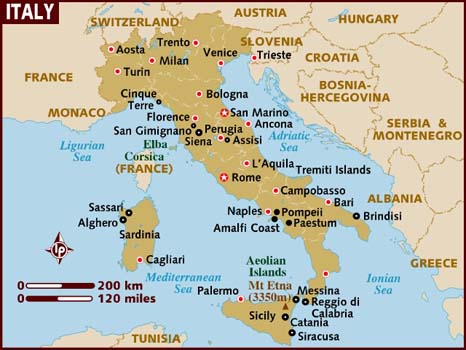
Introduction to the Country
Government and International Relationships
The official name of the country is the Repubblica Italiana which is translated into English as the Italian Republic (Berengo et al., 2019). The country’s government is split into two; the Chamber of Deputies and the Senate with both a President and a Prime Minister overseeing the government (Senato della Reubblica, n.d.).

Italy has been a force in the world, being a member of the Group of Seven (G7) which in combination represents 40% of the global GDP and 1/10 of the global population (BBC, 2019). Italy is also a member state within the European Union since 1 January 1958 and a member of the Schengen area since 26 October 1997 (European Union, n.d.). The Schengen are is an area within European that does not have internal boarders so citizens, business people, and tourists can move freely without boarder checks (Schengen Visa Info, n.d.).
Location and Population
The country of Italy is located in the Southern-Central region of Europe. It borders France, Switzerland, Austria, and Slovenia in the North with the Mediterranean and the Adriatic Sea boarding all of Italy’s coastline.
The population count in 2018 was approximately 60,452,000 spread out over the country’s 302,073 square kilometers (Berengo et al., 1998). Around 70.4% of the population live in Italy’s urban regions with the rest living in rural areas (Berengo et. Al., 1998). As with most other developed countries, the majority of the workforce is located within the urban areas, making them wealthier.
The Two Economies of the North and South of Italy
The wealth within this country is also divided from the North and South; some even noted that the country contains two economies (The Economist, 2015). The North of Italy is wealthier than the South due to a variety of reasons. The South of Italy has been unable to adapt to the changes both culturally and economically, which has arguably been due to their inability to change through two economic revolutions (Favaretto, 2017). The South of Italy has also is plagued by generational poverty. This has caused the brightest and wealthier to move out of the country either to other parts of Europe or to the Americas (Favaretto, 2017). The generational poverty has also caused organized crime, corruption among public and state employees and the underground economy to thrive which has arguably led to the inefficient investment by the Italian government which continues the cycle of poverty and its effects (Favaretto, 2018).

Recruitment Practices
The recruitment process in Italy is similar to the procedures in many other developed nations. Having a network is incredibly important so you can advance within your field and find a job (J.B.F. News 2017). This is enforced by it’s not what you know, but it is who you know, hence why maintaining relations is essential for the recruitment process. Italians value personal relationships, so maintaining them and asking for employment recommendations through those relationships is almost the most common way to get a job (GoinGlobal, 2019). For the job recruitment process, a cover letter and resume are required; however, they can be written in either English or Italian (GoinGlobal, 2019).
Things to consider when going in for a first or second interview are the following:
- Even though timeliness is not necessarily an Italian trait, the interviewee should be on time for the meeting.
- Shake hands both at the beginning and end of the interview; it shows respect for the interviewer. Also, respect titles as social status are more important in Italian culture.
- When asked about previous employment or experiences with past companies, never say anything negative, it can be perceived in a negative light.
- Along with a resume and cover letter, an interviewee should bring their business card to the meeting to re-enforce potential status.
It is common to have between two and four interviews as meeting an individual face to face and building a relationship with them is essential within Italian culture (GoinGlobal, 2019). Another standard part of the interview process is psychometric testing which can evaluate one’s ability to complete tasks, hand social situations and decisions, and the ability to handle numbers (GoinGlobal, 2019). To leave a good impression, the interviewee needs to follow up the interviewing and recruitment with a thank you email thanking them for their time and consideration.
Selection Practices
The selection process can take up to three months which is not uncommon for any job. The interviewee should not contact the company after the thank you email as any more contact after that can be perceived as pressure. Any pressure is viewed in a negative light and can lead to the interviewee being taken out of the selection process (GoinGlobal, 2019). Even if the time has gone past three months, let the company contact you and not the other way around.
Miscellaneous Information
Italian Employment Law
Within the Italian Constitution, there are several sections regarding labour rights.
- Section 4: every Italian citizen has the right to work
- Section 35: “protects work in all its forms and applications” (International Labour Organization, n.d.)
- Section 36: deals with fair pay, maximum working hours, and weekly/yearly vacation pay
- Section 37: protection of women and minors while on the job
- Section 38: “social insurance for old age, illness, invalidity, industrial diseases, and accidents” (International Labour Organizations, n.d.)
- Section 39: “on Freedom of Association” (International Labour Organization, n.d.)
- Section 40: the right to strike
An employee cannot be fired on the grounds of political opinion/association, trade union membership, sex, race, language or religious affiliation. The only occurrence where an employee can be fire without ground is when they are completing a trial period, considered a domestic worker, an employee who is over the retirement age and directors within a company (International Labour Organization, n.d.). If an employee is fired unfairly, then they have to challenge the termination in writing within 60 days and then they can file a claim with the Italian courts within 180 days (De Luca Tamajo e Soci, 2017). For an employee hired before 7 March 2015, compensation can range from 6 – 24 months salaries (De Luc Tamajo e Soci et al., 2017). An employee hired after 7 March 2015, compensation can go from 2 – 24 months salaries (De Luc Tamajo e Soci et al, 2017)
An individual must not work over 40 hours per week under Section 36 of the Constitution (International Labour Organization, n.d.). If they go into overtime, they much are paid an increase of 10% over their regular rate (International Labour Organization, n.d.). If an employee is a student, then they are by law required not to work overtime on Sunday and have paid time off to write exams (International Labour Organization, n.d.). In regards to paid leave, domestic workers are entitled to a minimum of eight days (International Labour Organization, n.d.). Whereas all other workers paid leave is determined under collective bargaining; however, it must not be under four weeks per year (International Labour Organization, n.d.).
Unions
There are more trade unionists within Italy, more than any other country in the European Union (Fulton, 2015). There are between 12 to 15 million trade union members within the country; however, it is estimated that half of them are retired (Fulton, 2015). In Italy, there are three main unions: Confederazione Generale Italiana del Lavoro (CGIL), Confederazione Italiana Sindacati Lavoratori (CISL), & Unione Italiana Del Lavoro (U.I.L.). The public sector has a 40% density rate when it comes to unions, whereas the private sectors have a lower density (Fulton, 2015). If a potential employee is going into a workspace, be aware of possible union involvement if hired.
As mentioned in the Italian Employment Section above, there are laws surrounding unions written. For example, an employee cannot be fired for a union association as per Italian law (International Labour Organization, n.d.).
Italian Holidays
Italy has eleven public holidays throughout the year. They are: New Year’s Day, Epiphany, Easter Monday, Liberation Day, Labour Day, Republic Day, Assumption, All Saint’s Day, Immaculate Conception, Christmas Day and St. Stephen’s Day (Governo Italiano, n.d.). Although a few of the above days rotate depending on what year, New Year’s Day, Republic Day, Assumption Day, All Saint’s Day, Immaculate Conception, Christmas Day and St. Stephen’s Day.
References
Accordo, P., De Matteis, A., & Mammone, G. (n.d.) National Labour Law Profile: Italy. Available at: https://www.ilo.org/ifpdial/information-resources/national-labour-law-profiles/WCMS_158903/lang–en/index.htm[Accessed on: 14 Oct 2019]
BBC (2019) What is the G7 summit and what does it do? Available at: https://www.bbc.com/news/world-49434667[Accessed on: 22 Oct 2019]
Berengo, M., Clark, M. et al. (1998) Italy. Available at: https://www.britannica.com/place/Italy [Accessed on: 14 Oct 2019]
De Luca Tamajo e Soci, T. & Toffoletto, F. (2017) Unfair Dismissal Under Italian Law: A Unique Dual-System. Available at: https://www.expertguides.com/articles/unfair-dismissal-under-italian-law-a-unique-dual-system/arzouvif [Accessed on: 22 Oct 2019]
European Union (n.d.) Italy. Available at: https://europa.eu/european-union/about-eu/countries/member-countries/italy_en [Accessed on: 22 Oct 2019]
Favaretto, A. (2018) The big Italian divide: why is Southern Italy poorer than the northern part? Available at: https://medium.com/@favaretto/the-big-italian-divide-why-is-southern-italy-poorer-than-the-northern-part-c1453195eabf [Accessed on: 14 Oct 2019]
Fulton, L. (2015) Trade Unions Available at: https://www.worker-participation.eu/National-Industrial-Relations/Countries/Italy/Trade-Unions [Accessed on: 14 Oct 2019]
GoinGlobal (2019) Interviewing in Italy. Available at: http://blog.goinglobal.com/interviewing-in-italy-2/ [Accessed on: 14 Oct 2019]
Governo Italiano (n.d.) Ufficio del Cerimoniale di Stato Available at: http://presidenza.governo.it/ufficio_cerimoniale/cerimoniale/giornate.html [Accessed on: 22 Oct 2019]
J.B.F. News (2017) How to Recruit in Italy. Available at: https://www.jobboardfinder.com/news/how-to-recruit-in-italy/[Accessed on: 14 Oct 2019]
Schengen Visa Info (n.d.) Schengen Area – The World’s Largest Visa Free Zone. Available at: https://www.schengenvisainfo.com/schengen-visa-countries-list/ [Accessed on: 22 Oct 2019]
Senato della Repubblicia (n.d.) Parliament. Available at: https://www.senato.it/3801 [Accessed on: 14 Oct 2019]
The Economist (2015) A tale of two economies. Available at: https://www.economist.com/finance-and-economics/2015/05/16/a-tale-of-two-economies [Accessed on: 14 Oct 2019]


